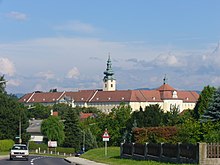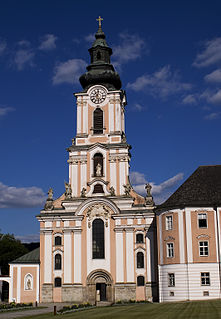
Seitenstetten Abbey (German : Stift Seitenstetten) is a Benedictine monastery in Seitenstetten in the Mostviertel region of Lower Austria.

Seitenstetten Abbey (German : Stift Seitenstetten) is a Benedictine monastery in Seitenstetten in the Mostviertel region of Lower Austria.
The monastery was founded in 1112 by Udalschalk, or Udiskalk, a relative of Bishop Ulrich of Passau, to which he gave all his estates as an endowment. In 1114 the new foundation was settled by monks from Göttweig Abbey. Bishop Ulrich dedicated the church in 1116 and granted the abbey the large parish of Aschbach. In 1142 it also received the large parish of Wolfsbach. Out of these two original parishes were formed the fourteen modern parishes for which the abbey is still responsible.
In about 1180 Archbishop Wichmann of Magdeburg granted the abbey the extensive woodlands on the Ybbs, with the duty of setting up a cell there and celebrating divine service in perpetuity. There is also some indication in the first century of the abbey's existence that there was already a school.
Despite many setbacks, including two serious fires and many disputes over property, the abbey gradually developed. In 1347 the community had 22 members. After a lengthy period of decline Abbot Benedikt I, formerly prior of the Schottenstift in Vienna, introduced the Melk Reforms at Seitenstetten, thus bringing about a revival in its spiritual and cultural life. This abbot had a chapel built and dedicated in 1440 on the Sonntagberg and so established the Sonntagberger Pilgrimage under the control and protection of the abbey.
Thereafter the abbey was hard hit by the Hungarian disturbances associated with Matthias Corvinus, the Turkish taxes and above all the Reformation; the number of monks declined sharply.

Not until the time of Abbot Christoph Held (1572–1602), with the powerful support of the Imperial Council, was any beginning of spiritual revival possible. Under the abbots that followed, the art of the Baroque made its appearance, and the number of monks was augmented by Bavarians and Swabians. But only after the Thirty Years' War did Abbot Gabriel Sauer (1648–74) finally succeed in stabilising the abbey economically and then in bringing about a true religious renewal.

Now it was also possible for major building work to begin. Abbot Benedikt II Abelzhauser (1687–1717) commissioned Jakob Prandtauer (succeeded in the work by his nephew Josef Munggenast) to build the magnificent Pilgrimage Church of the Holy Trinity on the Sonntagberg. The early Gothic abbey church was lavishly refurbished, including work by Franz Joseph Feuchtmayer. Between 1718 and 1747 the Baroque conventual buildings that still stand today were constructed. Ceiling frescoes in the Marble Hall (1735) and the library (1740) were executed by Paul Troger, while those on the grand staircase were by Bartolomeo Altomonte. The summer refectory contains 19 pictures by Kremser Schmidt.
The finance for these lavish works came principally from the abbey's copper mines in the Radmer (Styria) and the brass foundry at Reichraming (Upper Austria).
After the difficulties of the anti-monastic policies of Emperor Joseph II and of the Napoleonic wars, the abbey gradually regained its strength through the 19th century, until the time of Abbot Theodor Springer (1920–58), who not only brought the abbey safely through the economic crisis after World War I but also through the National Socialist period and World War II without its being dissolved, as so many other monasteries were.
Since the war more renovations have taken place both to the Pilgrimage Church and to the structure of the abbey itself.
Besides the major works of art and architecture mentioned previously, there are also the Romanesque Knights' Chapel (Ritterkapelle), the picture gallery, and the garden, which contains about 110 different types of rose, mostly historical.
Since 1625 the abbey has been a member of the Austrian Congregation, now within the Benedictine Confederation.

Ettal Abbey is a Benedictine monastery in the village of Ettal close to Oberammergau and Garmisch-Partenkirchen in Bavaria, Germany. With a community of more than 50 monks, with another five at Wechselburg, the Abbey is one of the largest Benedictine houses and is a major attraction for visitors.

Tegernsee Abbey is a former Benedictine monastery in the town and district of Tegernsee in Bavaria. Both the abbey and the town that grew up around it, are named after the Tegernsee, the lake on the shores of which they are located. The name is from the Old High German tegarin seo, meaning great lake.

Niederaltaich Abbey is a house of the Benedictine Order founded in 741, situated in the village of Niederalteich on the Danube in Bavaria.

Kremsmünster Abbey is a Benedictine monastery in Kremsmünster in Upper Austria.

Göttweig Abbey is a Benedictine monastery near Krems in Lower Austria. It was founded in 1083 by Altmann, Bishop of Passau.

Neresheim Abbey or the Abbey of Saints Ulrich and Afra, Neresheim is located above the town of Neresheim in Baden-Württemberg, southern Germany. It is now a Benedictine monastery and is part of the Beuronese Congregation.

Admont Abbey is a Benedictine monastery located on the Enns River in the town of Admont, Austria. The oldest remaining monastery in Styria, Admont Abbey contains the largest monastic library in the world as well as a long-established scientific collection. It is known for its Baroque architecture, art, and manuscripts.

St Peter's Abbey, or St Peter's Archabbey, is a Benedictine monastery and former cathedral in the Austrian city of Salzburg. It is considered one of the oldest monasteries in the German-speaking area, and in fact the oldest with a continuous history since its foundation in 696.

Altenburg Abbey is a Benedictine monastery in Altenburg, Lower Austria. It is situated about 30 kilometres (19 mi) to the north of Krems an der Donau in the Waldviertel. It was founded in 1144,by Countess Hildeburg of Poigen-Rebgau. Throughout its history it suffered numerous invasions and attacks, and was destroyed by the Swedes in 1645. Under Emperor Joseph II in 1793 the abbey was forbidden to accept new novices, but unlike many others in Austria it succeeded in remaining functional.

Saint Paul's Abbey in Lavanttal is a Benedictine monastery established in 1091 near the present-day market town of Sankt Paul im Lavanttal in the Austrian state of Carinthia. The premises centered on the Romanesque monastery church were largely rebuilt in a Baroque style in the 17th century.

Michaelbeuern Abbey is a Benedictine monastery in Dorfbeuern near Salzburg in Austria.
Münsterschwarzach Abbey, is a Benedictine monastery in Germany. It is located at the confluence of the rivers Schwarzach and Main in Bavaria.

Wilhering Abbey is a Cistercian monastery in Wilhering in Upper Austria, about 8 km (5 mi) from Linz. The buildings, re-constructed in the 18th century, are known for their spectacular Rococo decoration.

St. Georgenberg Abbey is a Benedictine monastery, the oldest extant monastery in the Tyrol, founded in 1138 but from 1708 to 2019 removed to the nearby city of Fiecht in the community of Vomp in Tyrol, Austria. In 2019 the monks returned to a restored abbey at St. Georgenberg, which had remained a place of pilgrimage and spiritual retreat.

St. Ulrich's and St. Afra's Abbey, Augsburg is a former Benedictine abbey dedicated to Saint Ulrich and Saint Afra in the south of the old city in Augsburg, Bavaria.
Seitenstetten is a town in the district of Amstetten in Lower Austria in Austria.

Wiblingen Abbey was a former Benedictine abbey which was later used as barracks. Today its buildings house several departments of the medical faculty of the University of Ulm. The former abbey is located south of the confluence of the rivers Danube and Iller, south of the city of Ulm in the German state of Baden-Württemberg. Administratively, the former independent village of Wiblingen now belongs to the city of Ulm. The abbey is part of the Upper Swabian Baroque Route.

Millstatt Abbey is a former monastery in Millstatt, Austria. Established by Benedictine monks about 1070, it ranks among the most important Romanesque buildings in the state of Carinthia. The Benedictines were succeeded by the knightly Order of Saint George in 1469 and the Society of Jesus in 1598.

Rein Abbey is a Cistercian monastery in Rein near Gratwein, Styria, in Austria. Also known as the "Cradle of Styria", it is the oldest surviving Cistercian community in the world.

Johann Jakob Zeiller was an Austrian painter.